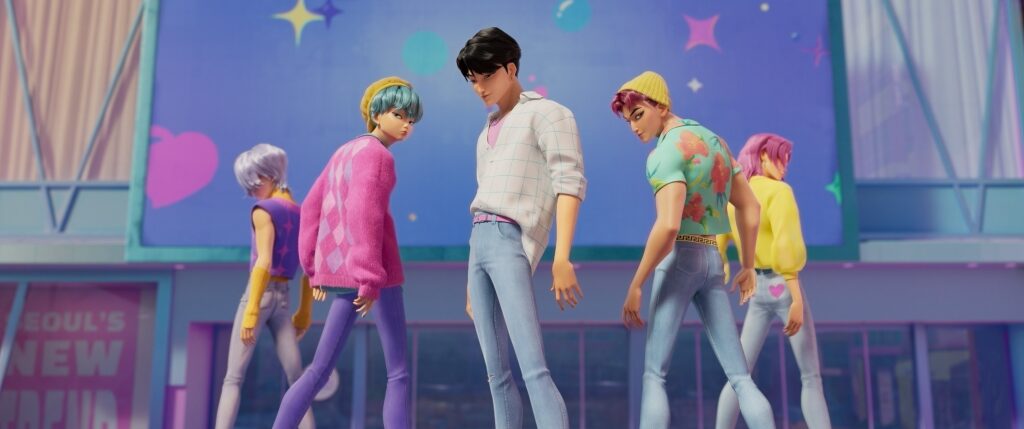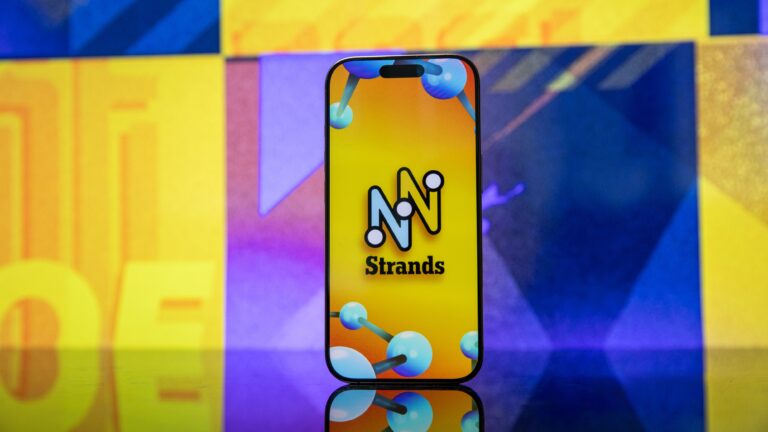

A great K-pop song surprises you. It doesn’t whisper its intentions; it shouts them in multiple languages with a dance break in the middle. And in Netflix’s K-pop Demon Hunters, those songs also have to tell a story.
Set in a supernatural world where idols double as demon slayers, the movie follows HUNTR/X, a powerhouse girl group navigating fame, friendship, and the fate of humanity. But building a believable fictional K-pop group, one that could go toe-to-toe on the charts with the likes of TWICE, meant assembling a team that deeply understood both pop structure and emotional storytelling. Enter executive music producer Ian Eisendrath, songwriter and vocalist EJAE, co-directors Maggie Kang and Chris Appelhans, and sonic heavyweights from THEBLACKLABEL, the music label founded by Teddy Park (the producer behind 2NE1 and BLACKPINK).
Together, they crafted seven original tracks that bridge worlds: K-pop and Broadway, fantasy and reality, maximalist production and narrative precision.
And what started as a fictional soundtrack for a demon-slaying girl group has become an actual pop phenomenon. The K-pop Demon Hunters cast soundtrack has soared far beyond expectations: hitting the Top 3 on the Billboard 200 (the highest-charting soundtrack of the year), topping Spotify’s Weekly Global Albums chart, and notching the largest streaming week for a soundtrack in two years. “Golden” became the highest-charting song by a K-pop girl group in U.S. Spotify history, while the villainous Saja Boys scored the first-ever U.S. Spotify No. 1 for a male K-pop group with their hypnotic track “Your Idol.” Not bad for a bunch of demons and slayers.
In the process of making the music for the film, the creative team also uncovered what makes a great K-pop song tick — and how to reverse-engineer one from scratch. Here’s how they did it.
Assemble the right team
To craft music that could stand toe-to-toe with real-world K-pop hits, the K-pop Demon Hunters team built a dream lineup of collaborators, mirroring how many K-pop tracks are made through close teamwork between multiple producers, topliners, and lyricists. A pivotal meeting in Seoul with THEBLACKLABEL founder Teddy Park brought industry authority and sonic firepower. Executive music producer Ian Eisendrath, known for his work on film and Broadway musicals, helped shape each track with cinematic precision. And songwriter EJAE, a former SM Entertainment trainee who’s written for some of K-pop’s biggest girl groups, lent both vocal power and industry-savvy storytelling. Together, they created songs that not only sounded like hits but also moved the story forward.
Maggie Kang [co-director]: We took the movie to THEBLACKLABEL, literally. We were in Teddy [Park]’s living room in Seoul. He’s very private and doesn’t really meet with people, so the fact that he sat down with us and said, “This is cool, guys,” was incredible. I mean, that’s Teddy. The coolest person telling you your project is cool? That’s huge.
Chris Appelhans [co-director]: The initial meeting was in late 2021 or maybe early 2022. It’s all kind of a blur.
Kang: They were really down to work with us, even though I think none of us fully understood how big the hill was to climb. The process was long, but like anything in animation, the longer you do it, the better you get. By the time we got to the finale, we just kept pushing it, adding more and more, making it better and better.
Ian Eisendrath [executive music producer]: When Spring Aspers at Sony called and asked if I wanted to do this, I was just like, “Yeah, that’s a dream job.” I wasn’t necessarily the first person you’d think of when it comes to K-pop, so I was quite honored to be asked. When I met with the team, I instantly knew what my role would be and how I could contribute to it, to help make sure the songs and the whole musical picture reached their fullest potential.
EJAE [songwriter, singing voice of Rumi]: I was a K-pop trainee myself at SM Entertainment for almost a decade, so that experience definitely helped me in the writing process and in connecting with the characters.
Start with story
Before a single hook or beat drop was written, the team built a story-first blueprint. Every emotional arc, character trait, and turning point had to be mapped out to determine where music could elevate the narrative, and what kind of song each moment demanded. Genre, tempo, topline, and even who should carry the chorus all stemmed from that scaffolding.
EJAE: It was actually very similar to how things work in the K-pop industry when creating new idol groups. I get sent many briefs of new idol groups from various K-pop companies, and they would give me a list of song references and a brief description of what kind of aesthetic, vibe, and sound they want their girl/boy group to be. The only difference was that there was a specific storyline and context we had to match the song and lyrics to.
Eisendrath: Early on, we really decided there are two kinds of songs in this film. One is diegetic: live performances that the characters are aware of. The other is more internal monologue: things the characters can’t say out loud, but that come through in song. K-pop doesn’t usually do that second part — storytelling through song — so that was an opportunity. We had to create lyrics that sounded like the characters and moved the story forward.
EJAE: We had to write the storyline within the lyrics. That was the hardest part, balancing narrative with catchiness. The balance between having a complex storyline fit within a 3-minute pop song, making it PG-friendly, and still sound hip and cool was definitely a challenge.
Eisendrath: We created prompt sheets, in collaboration with the directors — monologues from the character’s POV, notes on structure and timing, a vibe board of K-pop influences — and then spent time shepherding both the songwriting and how it interacted with the picture. But my goal and role was really to let these artists create the thing that only they can create. I’m not a Korean K-pop artist, so I wanted to really understand their world.
EJAE: Having a storyline set, it was a great “north star” that guided me and my co-writers to write lyrics and melodies that fit that narrative. However, it was also really difficult, since pop songs only have so many melodies, and if there are too many melodies or lines, the catchiness goes away.
Write for the character, not just the hook
Each song had to sound great, but more importantly, it had to feel like something a specific HUNTR/X member would sing. That meant tailoring melodies, ad-libs, and vocal parts to match the characters’ personalities.
EJAE: Having to write lyrics and melodies unique to each member’s characteristics was similar to how I write for K-pop. Oftentimes, A&Rs would ask to incorporate ad-libs or belting notes to show off the vocals of the main singer of the group. That’s what I did for the film as well.

Credit: Netflix
Appelhans: We wanted people to feel something when those high notes hit. It’s like an Olympic vault — you don’t know how they stuck it, but it gives you chills.
EJAE: Rumi was described as an incredible vocalist who could belt high notes. So, I had fun experimenting with different melodies that can really show off her vocals. But I also ended up hating myself in the recording studio because I ended up having to sing all those high notes…
Embrace maximalism
K-pop is known for genre mashups, bold production, and layers upon layers of vocals. The film team didn’t tone it down; they doubled down on it.
Eisendrath: Whenever I’ve heard K-pop, I’ve been like, oh my gosh, this genre is so theatrical and would so beautifully lend itself to film… So often when you’re working on film musicals, the music needs to be as exciting, as immersive, as dynamic, as everything you’re seeing… and K-pop already does that.
EJAE: One thing about K-pop demos is that they all sound radio-ready. They are mixed, have all the background harmonies, background vocals, and adlibs like in a finished record. I think that helped directors and everyone envision the scenes more.
Eisendrath: I’m a real fan of big, thick, exciting vocals. That’s something I love about K-pop: the number of vocal layers, the arrangements, the massive productions. There’s nothing subtle about it.
EJAE: Because HUNTR/X was a mash of a lot of different K-pop girl group styles, it was fun to incorporate all the different styles I’ve written for different types of girl groups — some more cute, some more badass, and some more vocal/melody heavy. For example, sometimes the verses would be more badass and rap heavy, and the pre-chorus and hook more melodic and power vocals. K-pop is very maximalist when it comes to vocal production and production. Even when I write for aespa or Red Velvet, there are a lot of harmonies and background vocals to bring more depth and richness to the songs. That translated beautifully into film. All the vocal layering and harmonies made the song more cinematic!
The drop is sacred
In K-pop, the drop isn’t just a beat; it’s a declaration. It’s the seismic pulse that launches a chorus, powers a dance break, and leaves an imprint long after the song ends. For K-pop Demon Hunters, that moment had to hit like divine intervention.
Eisendrath: You find the groove, you find the song. Especially with tracks like “Takedown” and “How It’s Done,” the drop had to feel like K-pop — massive emotional payoff with very few words.
Kang: Obviously, there are shades of 2NE1 and BLACKPINK. That’s Teddy’s legacy. But THEBLACKLABEL and Teddy didn’t want to just do the same thing again. They were committed to creating something new. You can still hear that signature sound, but each of our girl group songs is so different, you can’t really compare them to one group. One thing we always had to remind people was: these girls are warriors. They’re not just idols, they fight demons. That brought a whole different kind of energy and attitude to the music.
Eisendrath: The opening [“How It’s Done”] sets up that we have these three K-pop idols, their personalities, their character, and the fact that they are unbeatable. It’s really more of an “I am” or “We are” song. But then we also really wanted to include demon fighting and that exciting arrival at a concert in a stadium. So it had to do all of those things. We wanted to make sure we kicked off the movie with something that sounded authentically like a K-pop song from THEBLACKLABEL.
Let the song evolve
Nothing was set in stone. The music, like the story, was revised repeatedly until it matched the emotional beats of the film.
Eisendrath: None of the songs in the film now were the songs we started with. We did many versions of each one. The finale track went through eight full versions. The opening had four totally different songs before we landed on the one that worked.
Maggie Kang [co-director]: We did many, many iterations of each song. As the story evolved, so did the lyrics and sometimes the entire intent of the song. It was a very interesting process. None of us had worked on a musical before, and so this was a really complex storytelling puzzle.
Eisendrath: The finale was the hardest to crack. As the story evolved, so did the needs of that final song. It had to be inspiring, but not cheesy. It had to reflect a new sound for our lead character, one that embraces all the different parts of who she is, not just the version of her that the K-pop industry expected. And it also had to tie everything together: the demon-fighting, the love story, the emotional resolution. There’s even this moment of collective awakening, where everyone who’s been numbed out by the demons starts to come back to themselves. It’s like a singing revolution. Finding the right tone, the right energy, the right message — it just took time. But it was worth it.
Appelhans: The finale just kept getting bigger.
Eisendrath: With pop music, you make it in a period of time and release it. But in animation, the story changes, and so do the songs. One of our writers recently joked, “I thought you were going to ask for one more major revision two weeks before release.”
Aim for emotional pop, not musical theater
One of the hardest challenges? Making sure the songs didn’t just sound like musical numbers with a pop beat.
Eisendrath: We always made sure: If we were going to choose, the pop hook and vibe won out. If it ever started sounding too Broadway, we had to go back.
Appelhans: We didn’t want these songs to feel like “musical” songs. They had to be real bops, but they also had to carry emotional weight.
EJAE: It also couldn’t be too simplified, where the story doesn’t come through.
Eisendrath: The challenge was: How do you make a K-pop song do what a musical theater song does — get a character from A to B emotionally — without losing that polished, exciting pop feel?
Appelhans: When we finally figured out what the group meant to each other, that’s when songs like ‘Golden’ finally clicked. It was like writing from a real emotional place.
Flip the fantasy
In K-Pop Demon Hunters, the villains aren’t just demons — they’re idols, too. Saja Boy, the film’s fictional boy group, was designed as a dark mirror of HUNTR/X, using bubblegum charm to hide a much more sinister agenda.
Eisendrath: The idea was that the demons realize HUNTR/X is dominating the fandom, and if HUNTR/X wins, the demons lose everything. So they decide to become a K-pop boy group themselves. “Soda Pop” had to feel sweet and innocent, almost veiled, to mask their true nature. It’s that ultra-polished, feel-good boy band vibe…until they’re in control. Then they no longer need to hide.
Appelhans: We wanted the Saja Boy songs to be incredibly good and catchy earworms, but at their core, they’re hollow. There’s no soul in them. They’re meant to feel a little toxic underneath the polish. That doesn’t make them lesser pop songs, but there’s no truth there, there’s no soul in them. The HUNTR/X songs, on the other hand, are emotionally honest. We were saying the other day: The superficial part of your heart might fall for the boys, but the deeper part is moved by the girls.
Kang: Lyrically, the Saja Boy songs are like, “give me give me give me.” But the finale, that’s HUNTR/X giving something back. They’re giving themselves to the audience.
Eisendrath: That’s where “Your Idol” comes in. It’s the flip side — seductive, obsessive, and frankly disturbing. It’s a twisted version of K-pop fandom. The fans are so deep under their spell that the demons can literally feed off their souls. They’re singing, “Worship me. You need me. You belong to me.”
Kang: I’m so surprised we got away with that scene. We’re very proud of it because it just goes so dark and it goes so hard. And we were like, let’s just go harder. And we just kept pushing it.
So, what makes a perfect K-pop song?
The team agrees: It’s a blend of complexity, catchiness, and emotion, and it should be a little bit hard to sing.
EJAE: What makes a great K-pop song that’s different from pop songs is how complex and diverse one song can be. Chord changes, beat switch-ups, and having multiple melodies are what keep the listeners on their toes. The quirky fusion of genres and styles is what I feel is the charm of K-pop. But with all that complexity, all great K-pop songs have a strong hook/chorus and concept that grabs your attention and that everyone can sing along to.
Kang: I told EJAE: Make the songs hard to sing. For me, great pop songs are the ones you want to belt in the car. That’s what makes them stick. I believe it’s part of our karaoke culture. A good K-pop song is one that challenges your voice, that you want to master. That’s the bar I wanted to hit.
Appelhans: You hear someone hit that impossible note, and it just gives you chills. That’s what we wanted these songs to do.
Kang: I try to sing “Golden” every day, and I still can’t.




